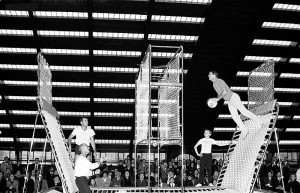The first modern trampoline was built by George Nissen and Larry Griswold in 1936. Nissen was a gymnastics and diving competitor and Griswold was a tumbler on the gymnastics team, both at the University of Iowa, USA. They had observed trapeze artists using a tight net to add entertainment value to their performance and experimented by stretching a piece of canvas, in which they had inserted grommets along each side, to an angle iron frame by means of coiled springs. It was initially used to train tumblers but soon became popular in its own right. Nissen explained that the name came from the Spanish trampolín, meaning a diving board. George Nissen had heard the word on a demonstration tour in Mexico in the late 1930s and decided to use an anglicized form as the trademark for the apparatus.
In 1942, Griswold and Nissen created the Griswold-Nissen Trampoline & Tumbling Company, and began making trampolines commercially in Cedar Rapids, Iowa.
The generic term for the trademarked trampoline was a rebound tumbler and the sport began as rebound tumbling. It has since lost its trademark and has become a generic trademark.
1968 demonstration of Spaceball.
Early in their development Nissen anticipated trampolines being used in a number of recreational areas, including those involving more than one participant on the same trampoline. One such game was Spaceball—a game of two teams of two on a single trampoline with specially constructed end “walls” and a middle “wall” through which a ball could be propelled to hit a target on the other sides end wall.
Use in flight and astronaut training
During World War II, the United States Navy Flight School developed the use of the trampoline in its training of pilots and navigators, giving them concentrated practice in spatial orientation that had not been possible before. After the war, the development of the space flight programme again brought the trampoline into use to help train both American and Soviet astronauts, giving them experience of variable body positions in flight.
Competitive sports
One of the earliest pioneers of trampoline as a competitive sport was Jeff Hennessy, a coach at the University of Louisiana at Lafayette. Hennessy also coached the United States trampoline team, producing more world champions than any other person. Among his world champions was his daughter,Leigh Hennessy. Both Jeff and Leigh Hennessy are in the USA Gymnastics Hall of Fame.
The competitive gymnastic sport of trampolining has been part of the Olympic Games since 2000. On a modern competitive trampoline, a skilled athlete can bounce to a height of up to 10 metres (33 ft), performing multiple somersaults and twists. Trampolines also feature in the competitive sport of Slamball, a variant of basketball, and Bossaball, a variant of volleyball.
Cross-training for other sports
There are a number of other sports that use trampolines to help develop and hone acrobatic skills in training before they are used in the actual sporting venue. Examples can be found in diving, gymnastics, and freestyle skiing.



Speak Your Mind
You must be logged in to post a comment.